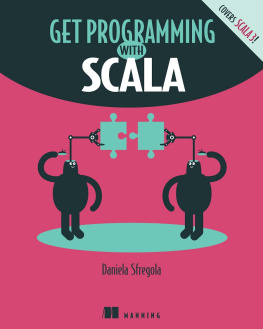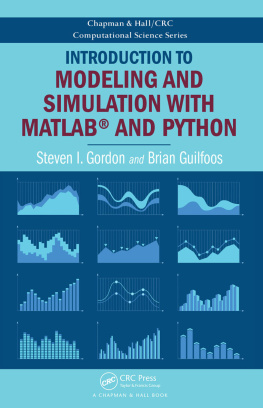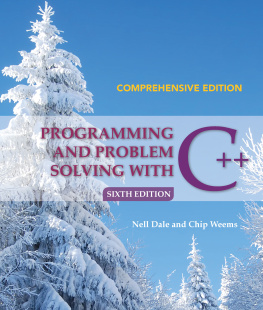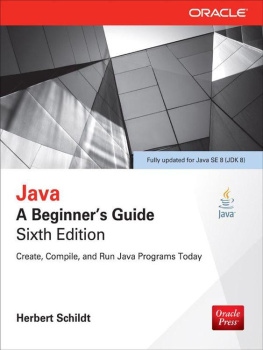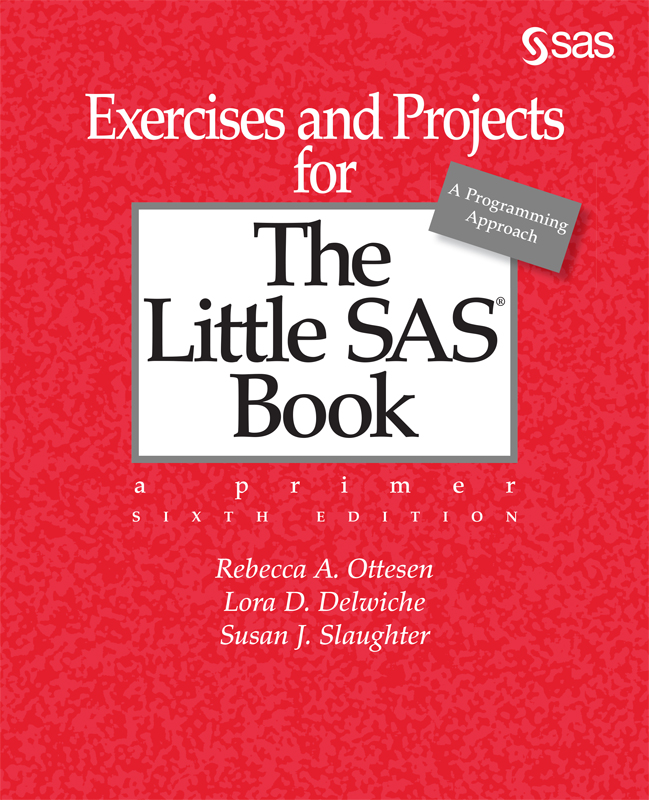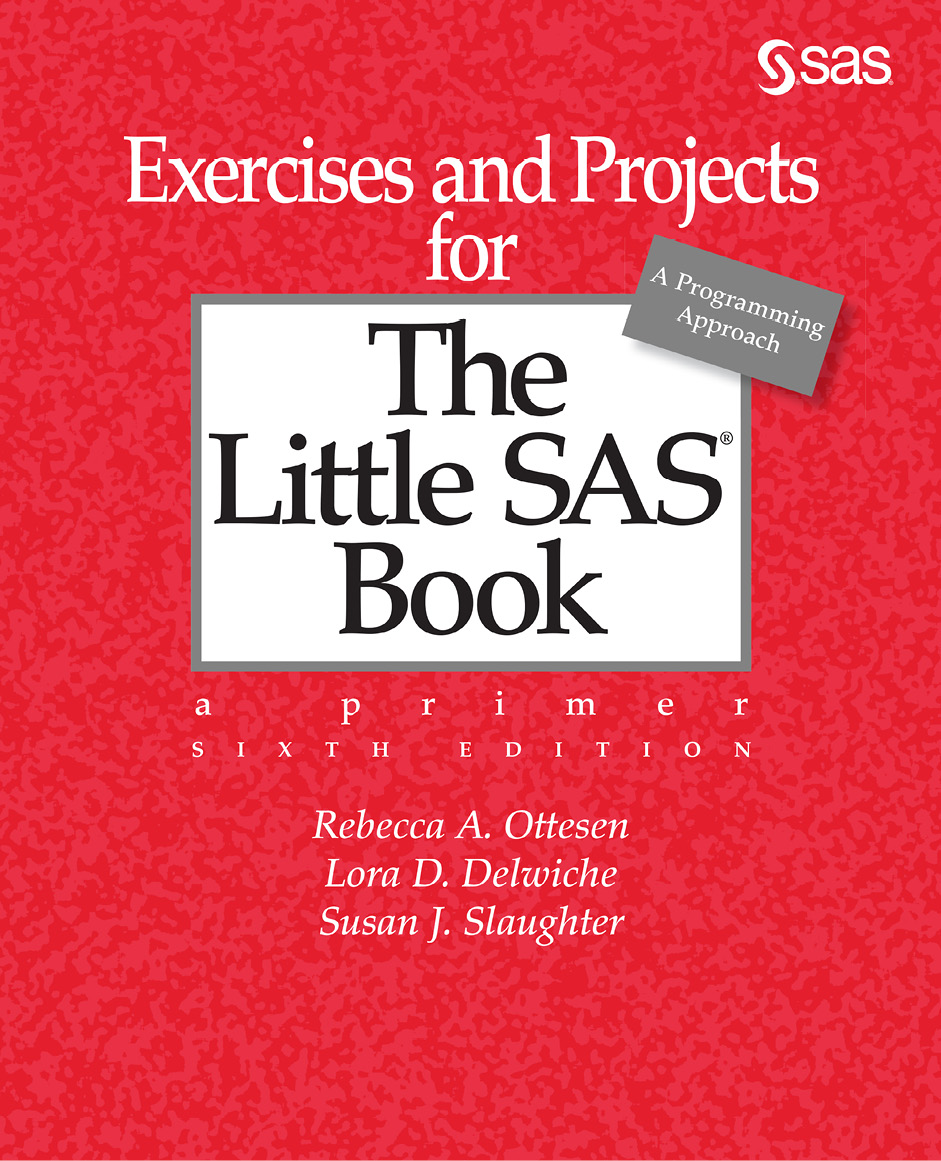The correct bibliographic citation for this manual is as follows: Ottesen, Rebecca A., Lora D. Delwiche, and Susan J. Slaughter. 2020. Exercises and Projects for The Little SAS Book, Sixth Edition. Cary, NC: SAS Institute Inc.
Exercises and Projects for The Little SAS Book, Sixth Edition
Copyright 2020, SAS Institute Inc., Cary, NC, USA
ISBN 978-1-64295-617-7 (Hard cover)
ISBN 978-1-64295-284-1 (Paperback)
ISBN 978-1-64295-524-8 (Web PDF)
ISBN 978-1-64295-525-5 (epub)
ISBN 978-1-64295-526-2 (Kindle)
All Rights Reserved. Produced in the United States of America.
For a hard copy book: No part of this publication may be reproduced, stored in a retrieval system, or transmitted, in any form or by any means, electronic, mechanical, photocopying, or otherwise, without the prior written permission of the publisher, SAS Institute Inc.
For a web download or e-book: Your use of this publication shall be governed by the terms established by the vendor at the time you acquire this publication.
The scanning, uploading, and distribution of this book via the Internet or any other means without the permission of the publisher is illegal and punishable by law. Please purchase only authorized electronic editions and do not participate in or encourage electronic piracy of copyrighted materials. Your support of others rights is appreciated.
U.S. Government License Rights; Restricted Rights: The Software and its documentation is commercial computer software developed at private expense and is provided with RESTRICTED RIGHTS to the United States Government. Use, duplication, or disclosure of the Software by the United States Government is subject to the license terms of this Agreement pursuant to, as applicable, FAR 12.212, DFAR 227.7202-1(a), DFAR 227.7202-3(a), and DFAR 227.7202-4, and, to the extent required under U.S. federal law, the minimum restricted rights as set out in FAR 52.227-19 (DEC 2007). If FAR 52.227-19 is applicable, this provision serves as notice under clause (c) thereof and no other notice is required to be affixed to the Software or documentation. The Governments rights in Software and documentation shall be only those set forth in this Agreement.
SAS Institute Inc., SAS Campus Drive, Cary, NC 27513-2414
January 2020
SAS and all other SAS Institute Inc. product or service names are registered trademarks or trademarks of SAS Institute Inc. in the USA and other countries. indicates USA registration.
Other brand and product names are trademarks of their respective companies.
SAS software may be provided with certain third-party software, including but not limited to open-source software, which is licensed under its applicable third-party software license agreement. For license information about third-party software distributed with SAS software, refer to http://support.sas.com/thirdpartylicenses .
Contents
About This Book
Who should use this book This book was written for anyone who wants hands-on experience while learning or practicing the basics of SAS programming. The exercises and projects in this book are designed so that they can be used in a classroom setting or by an individual reader working alone.
Content This book consists of exercises (with selected solutions) and projects. Each chapter in this book covers the same material as the corresponding chapter in The Little SAS Book, Sixth Edition . The content in each chapter builds on previous chapters, so we do not expect a reader to use a technique in one chapter that is introduced in a later chapter.
Exercises There are three types of exercises in this book: multiple choice, short answer, and programming. Each type of exercise is designed to improve the comprehension of topics and syntax, and to develop SAS coding skills with realistic data sets.
Solutions Solutions are provided for odd-numbered multiple choice and short answer questions. Solutions are not provided for programming exercises, but hints are provided to help give readers direction.
Projects The projects in the final chapter are designed to serve as a comprehensive capstone for the programming skills developed throughout the book. Each project gives readers a chance to synthesize the material learned from various chapters. Completing a project will take several days of intense thought and coding, and will result in a final product that could serve as evidence of SAS proficiency to a future employer or course instructor. Projects can be completed by a group or an individual.
Typographical Conventions This book uses the same typographical conventions as The Little SAS Book . SAS doesnt care whether your programs are written in uppercase or lowercase, so you can write your programs any way you want. In this book, we have used uppercase and lowercase to tell you something. All SAS keywords appear in uppercase letters. A keyword is an instruction to SAS and must be spelled correctly. Anything that programmers make up such as variable names, names for SAS data sets, comments, or titles are generally shown in lowercase or mixed-case letters.
Data Sets We have tried to include programming exercises with data sets that are somewhat large, unruly, and messy. We hope that this will help our readers develop their skills more fully. Some of the exercises are based on data that come directly from public sources, while others have been designed to mimic real-life scenarios.
The data sets for exercises can be accessed via web pages for any of the authors of this book at the support site for SAS, .
The projects in the final chapter use real data. We give instructions for locating and downloading the data from primary sources so that you will have the most up-to-date and authentic data possible.
How to use this book The exercises are organized in such a way as to help readers develop useful and sensible programming habits. Readers are encouraged to examine all raw data files and SAS data sets they will be accessing before writing any code.
In many of the programming exercises, we do not explicitly ask the reader to use a particular function or procedure. This was intentional in order to provide users with the opportunity to develop code based on what they learned from the topics that are covered in the corresponding chapter. This means that the code written by one person may not be the same as that written by another person, even though they both may arrive at the same answer.
While the material presented in the book includes exercises for certain graphical and statistical analyses, the purpose of these chapters is merely to introduce the basic syntax and concepts, and not the fine details of the analysis itself. This book may be used in a statistics course as a programming supplement. However, it should not be considered a statistical textbook.
Compatibility with SAS software This book was developed using SAS 9.4, but the exercises are compatible with SAS 9.3 and later. Most exercises require only Base SAS, but a few in Chapter 9 require SAS/STAT, and a few in Chapters 2 and 10 require SAS/ACCESS Interface to PC Files. The exercises in this book were designed to be programmed in the SAS windowing environment, SAS Enterprise Guide, SAS Studio, SAS OnDemand for Academics, or the SAS University Edition through SAS Analytics U. We have noted the few instances when an exercise is specific to the SAS windowing environment. Otherwise, the exercise can be considered environment-independent. Path references in this book are, however, specific to Microsoft Windows, and may need to be adjusted for other environments such as UNIX, Linux, or z/OS. (SAS University Edition runs in a Linux environment even if you are using a Windows PC.)



